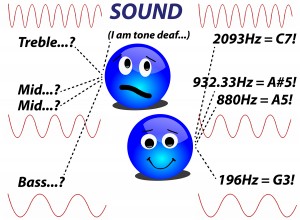 Have you ever met someone who has a perfect pitch? It is pretty cool. I once asked a friend who had perfect pitch if he could tell me what note a street building ventilation system was producing. He listened for a minute and said: “Just below Bb.” I loaded my tuner app to check and sure enough he was spot on.
Have you ever met someone who has a perfect pitch? It is pretty cool. I once asked a friend who had perfect pitch if he could tell me what note a street building ventilation system was producing. He listened for a minute and said: “Just below Bb.” I loaded my tuner app to check and sure enough he was spot on.
In reality, most people can’t do this. Instead, they have relative pitch, which means that when they hear a certain note they can then determine other notes relative to that one. One can develop this relative pitch more through practice and listening, yet even then, if you play someone a note and ask what note it is, they will still at most make a rough guess whether it is in the bass, mid or treble range.
Throughout the years I myself have learned to hear how certain note intervals, chords and chord progressions sound and how notes relate to each other, but if you played me a note I still wouldn’t know what note it actually is. In fact, I perceive music more visually than through hearing which makes it even harder for me to “hear it”. I visualize scales and calculate and count relationships between notes.
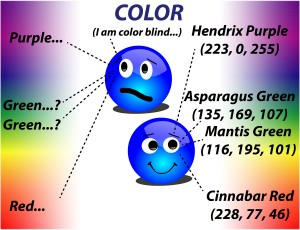 Some people that have not been exposed to or practiced listening to sound and music could even be left intimidated and just claim that they are “tone deaf” and that they have no musical capabilities whatsoever. Imagine I showed you a green color and the next day I showed you a similar green color and asked you to identify whether it were the same color? Would you be able to do it?
Some people that have not been exposed to or practiced listening to sound and music could even be left intimidated and just claim that they are “tone deaf” and that they have no musical capabilities whatsoever. Imagine I showed you a green color and the next day I showed you a similar green color and asked you to identify whether it were the same color? Would you be able to do it?
Just like very few people have a “perfect pitch” with sound, I’d imagine there are certain people that can truly recognize and distinguish colors. They give them names and perhaps even learn to identify them by their 3-digit RGB codes. Yet just like with sound, most people are geared to recognize relative differences between colors when they can see them side by side. I once saw a deep red color that I really liked and which I found out was called Cinnabar. I wrote and named a song after it, yet in full honesty, I’d need to google the color in order to fully recognize it again. Some people are actually color blind and can’t tell certain colors apart from others.
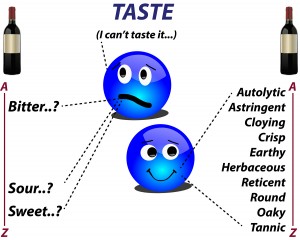 Lets explore our taste buds in the same way. For example, I enjoy drinking my wine, but other than remembering the wine I like by memorizing its label, I am unlikely to distinguish its actual taste features at a later time. Technically speaking, I am “taste blind”. 😉
Lets explore our taste buds in the same way. For example, I enjoy drinking my wine, but other than remembering the wine I like by memorizing its label, I am unlikely to distinguish its actual taste features at a later time. Technically speaking, I am “taste blind”. 😉
Yet wine connoisseurs have developed a rich “A-Z” language to describe the spectrum of wine tastes. And just like most of us have the ability to tell different wines apart relatively to each other in the moment, there are people out there whose taste senses retain the exact characteristics of these different wines. Scent is similar to taste. Some people can also have a very acute sense for smells.
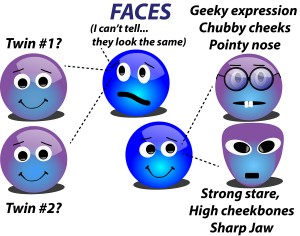 As I have a twin brother, I have met people for the first time who thought that they couldn’t tell us apart at all, and I have also met others that just couldn’t see any similarity between us. I always found this intriguing. I realize now that different people notice different facial features. Our perceptions can be very selective. Some people might pay attention to the similarity of eyebrows and smile, yet not notice that the nose and cheeks look completely different.
As I have a twin brother, I have met people for the first time who thought that they couldn’t tell us apart at all, and I have also met others that just couldn’t see any similarity between us. I always found this intriguing. I realize now that different people notice different facial features. Our perceptions can be very selective. Some people might pay attention to the similarity of eyebrows and smile, yet not notice that the nose and cheeks look completely different.
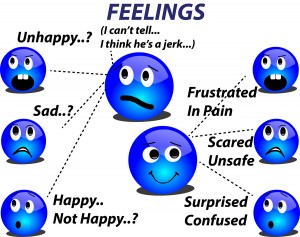 This is where our visual perceptions become more complex than just recognizing one thing at a time like one color. People contain many things that make them distinct. Various facial shapes can be complemented with a specific skin tone color, color of eyes, hair, the sound of voice and so on. Let’s add mirror neurons to all the complexity of senses: the ability to distinguish feelings in others. Facial expressions and behaviors give us an abundance of cues as to what is going on for another person. And how good are most people at noticing and distinguishing what is going on for others?
This is where our visual perceptions become more complex than just recognizing one thing at a time like one color. People contain many things that make them distinct. Various facial shapes can be complemented with a specific skin tone color, color of eyes, hair, the sound of voice and so on. Let’s add mirror neurons to all the complexity of senses: the ability to distinguish feelings in others. Facial expressions and behaviors give us an abundance of cues as to what is going on for another person. And how good are most people at noticing and distinguishing what is going on for others?
Add to that our society’s fear of and condemnation of emotion expression in itself, which actually deters many people from even focusing on them. Most people generally sense when someone is mad, sad or happy. There are people out there that are very attuned to emotional states of others and notice every little thing. On the flip-side, an autistic person would consider everyone around them to have a “perfect pitch” for emotions.
Some people have trained themselves to not pay attention to emotions at all. And what do people usually do when they are not wanting to focus on others’ emotions, especially if someone around them is being “overly emotional”? They judge the people directly, they call them names, they label them as crazy, intense, over the top, as jerks, as needy or hard to deal with. None of us have “perfect” senses. Very few are naturally very sensitive and most of the time this can even be a hindrance for them. My friend with the perfect pitch said that hearing everything would really distract and annoy him as he was growing up.A person who senses every emotion in everyone can easily get overwhelmed with all the sensory information. It can take years for them to learn to integrate it all. Some people have synesthesia, which is when their senses are mixed up, for example if someone hears in colors. Very few people are savants and perform incredible mental activities.
Sometimes we label people snobs when in reality they just happen to notice a lot. On the other hand, sometimes people claim they can perceive more than they in reality can, to avoid embarrassment, save face or simply look cool. And then, there are occasions when some people have merely convinced themselves that they have tapped into a “perfect tuning” with something without even being aware of it.
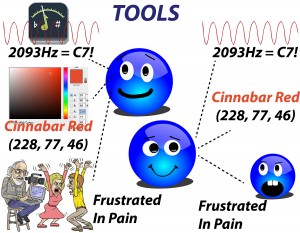 We don’t need to have “perfect” senses but for what they are, we can still develop and fine-tune them and be honest with ourselves at where we are at. To do this, humans have been very good with developing a variety of tools to examine the environment around them.
We don’t need to have “perfect” senses but for what they are, we can still develop and fine-tune them and be honest with ourselves at where we are at. To do this, humans have been very good with developing a variety of tools to examine the environment around them.
Some of these are physical tools. For example, a tuner to figure out a given note, a color picker in computer applications to figure out a specific color. Some are tools for measuring, like mathematics, tools for coordination, like geometry, tools for thinking like logical rules of deduction, some of them are tools for observing and understanding emotions, like the one developed by John Gottman’s institute.
These all have immensely helped us get closer to understanding and learning the world around us and ourselves. And this is just the tip of the iceberg. In this highly complex process, one can still enjoy a good glass of wine regardless whether they notice there is a hint of decaying mint leaves in the taste that they can’t do without. One can still fully enjoy a musical composition despite having to know what kind of a modal shift might have happened at a given moment. One can enjoy watching a sunset without nitpicking the spectral ranges of the blending of the colors. We can fully enjoy someone’s company even if we don’t understand their personality traits. Yet, if one’s aspirations are to learn about the world, the process of gaining a deeper understanding of how it all works can bring immense enjoyment.
The challenge is to accept that our understanding of the world is very limited and “relative” and that we ought to be careful when we take our own opinion of something too seriously. People who have a “perfect pitch” for something usually won’t get upset if you don’t agree with them, if need be, they will simply demonstrate their skill. It is when we are too invested in proving to someone that we are right about something not because we can literally sense it, but because we read a book or an article on the topic. When we do this, we first risk losing the relationship with that person and second, we head-butt from our own pedestal of self-importance with another person who is usually on a similar pedestal of their own. People argue and fight and make fools of themselves, rather than step off their pedestals into the “relative zone” where everyone (including themselves) realistically are, from where everyone can view these two different points together and collectively explore their validity with the aim of understanding the world further.
The bottom line is, learn to first build the relationship and then explore the world together. And remember this one: these days you don’t have to watch if the birds fly low or observe the red sky or a bright moon to predict whether it will rain.
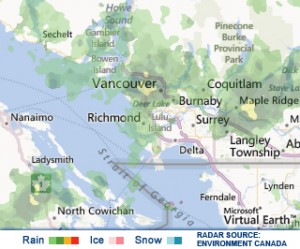 The Weather Network App gives us a real-time map of the current sky view and the rainy clouds coming in. And in my prediction, it’s just a matter of time when this will be integrated into the google and apple map views. Can’t wait!
The Weather Network App gives us a real-time map of the current sky view and the rainy clouds coming in. And in my prediction, it’s just a matter of time when this will be integrated into the google and apple map views. Can’t wait!
Thanks for reading and enjoy your next venture of senses! 😉
Ivan
